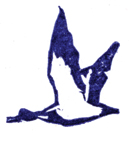|
|
 Around Pill
Wildlife
- Look out for herons (below) nesting in trees on the north side of the river between the Powder House and the Horseshoe Bend.
- Birds of the river's mouth that you may see include the shelduck (right), oystercatcher and tufted duck. Wading birds look for food at low tide.
 Geology
Between Pill and Bath the River Avon cuts through different rocks formed over the last 400 million years. This provides us with evidence for other ancient rivers, seas, a tropical rain forest and the Ice Ages. The river also provided a means of transport for the rocks which were quarried along the valley.
Between Pill and the Avon Gorge, the river has cut back on the outside of its meanders to expose flat lying layers of rock full of pebbles. The conglomerate is over 200 million years old (Triassic age) and is easily seen at Hung Road and the Horseshoe Bend. The other rock in this area is mostly steeply tilted sandstone that is nearly 400 million years old (Devonian age), and the river has eroded it back to form a broad valley.
Both ages of rock were originally sand and pebbles carried by ancient rivers in desert climates. The older sandstone sometimes contains fossil fish and fern remains, while a few dinosaur bones have been found in the younger conglomerate. The Devonian rocks are the oldest to be seen
along the River Avon Trail.
A Forgotten Landscape is a natural and cultural heritage project extending across the unique geology of Lower Severn Vale Levels to the north side of the River Avon.
|
|


